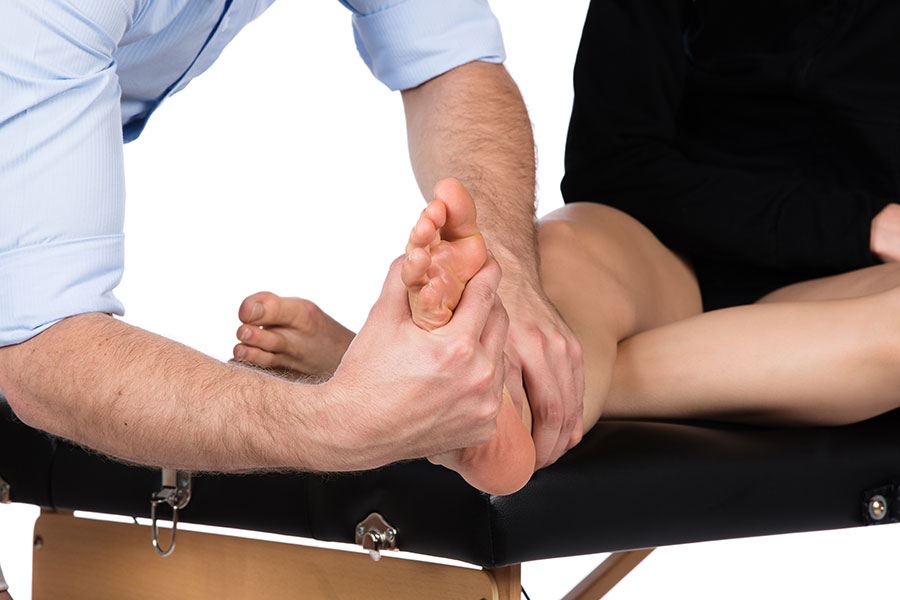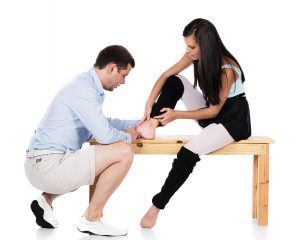Ankle Sprain – The Lateral Ankle Ligament Sprain
A Lateral ankle sprain is the most common sports-related injury that physiotherapist see. This is also the most widespread type of ankle sprain. An Ankle sprain is where one or more of the ankle ligaments are injured. As much as 85% of ankle sprains are lateral ankle sprain where one of the three outside ligaments of the ankle is partially or completely torn. Although a common, injury poor rehabilitation can result in a chronically painful ankle, with reduced function and a high rate of re-injury. The biggest concern is that only half of the people suffering an ankle ligament sprain seeks medical attention and unfortunately, a large number of those that don’t develop chronic ankle instability (CAI).
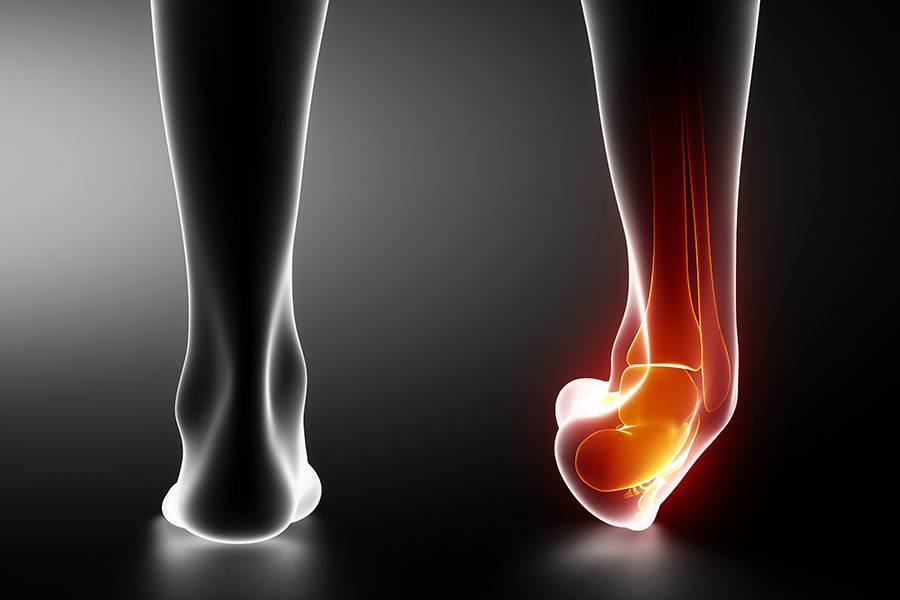
Anatomy of a lateral ankle sprain
The ankle joint is made up by two shin bones namely the tibia (inside, thick and weight bearing) and fibula (outside, thin and non-weight bearing) with the foot bones resulting in three main joints:
The talocrural joint (true ankle joint):
The joint between the lower parts of the shin bones, the tibia and fibula with the foot bone (talus). The joint is a typical hinge joint moving up and down.
- The ankle joint can move up called dorsiflexion and move down called plantarflexion. The joint is the most unstable in plantarflexion, i.e. toes pointed. The risk for injury is high in this position.
Inferior tibiofibular joint (bottom shin bones joint):
The joint between the lower parts of the shin bones at the base of the ankle, namely the tibia (inside, thick and weight bearing) and fibula (outside, thin and non-weight bearing).
- The Inferior tibiofibular joint has very limited rotatory movement, but is a necessity for normal walking and running.
Subtalar joint (shock absorbing joint):
The joint between the talus (top foot bone) and the heel bone (calcaneus).
- The subtalar joint adjusts to uneven surfaces by allowing the foot to stay flat. It allows for the movement of tilting the sole inwards (inversion) to stand on the outside of the foot in addition to tilting the sole outwards (eversion) to stand on the inside surface of the foot.
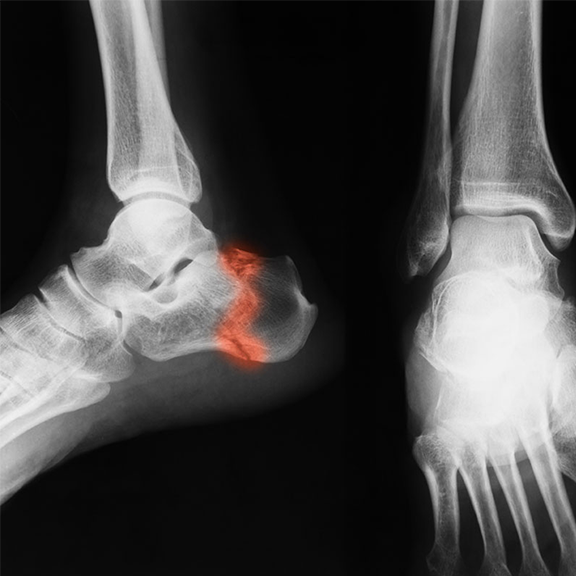
4. Ligaments
The ligaments on the outside of the foot are the anterior talo-fibular ligament (ATFL), the calcaneo-fibular ligament (CFL) and the posterior talo-fibular ligament (PTFL). The inside of the foot (deltoid) ligament is much stronger than the lateral ligament and is therefore injured much less frequently. The joints, ligaments and joint capsule provide the natural stability of the ankle.
The muscles and their tendons provide stability during movements. The calf muscles (soleus and gastrocnemius) plantarflexes and the tibialis anterior dorsiflex the ankle. The peroneal muscle group found on the outside of the leg turns the foot out (everts) and the tibialis posterior tilt the foot in (inverts).
What does the lateral ankle ligaments do?
The three ligaments provide stability to the ankle and provide joint position sense (proprioception) to the brain to help it determine how the ankle is positioned. This prevents you from rolling in on your own ankle when you run or land awkwardly from a jump. The ligaments are made of collagen fibres which act like cables holding up a bridge. Above all the ligaments provide passive support resisting excessive movement.
ATFL
The anterior talo-fibular ligament (ATFL) is the foremost of the ligaments and is a flat thin band that is the most commonly injured ligament. It prevents the ankle from sliding forward and is damaged when you roll in over your ankle when your toes are pointed to the ground, i.e. in plantar flexion.
CFL
The calcaneo-fibular ligament (CFL) is cord-like and is the centre of the three ligaments. It is usually injured secondary to the AFTL when rolling the ankle with the toes pointed. It, however, is injured first when rolling over the ankle when the foot is planted flat.
PTFL
The posterior talofibular ligaments (PTFL) is a very short ligament right at the back and is injured secondary to the CFL when rolling over the ankle when the foot is planted flat.
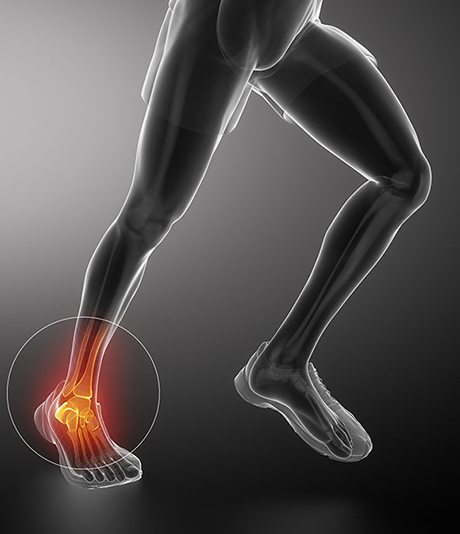
How does an ankle ligament get injured?
Initial injury
The ligaments get injured when the ankle has a sudden twist. The twist stretches the ligaments beyond their normal limits. The ligament then starts to tear or fray like a rope. The most common type of ankle sprain occurs when the ankle rolls so that the sole faces inwards. Also known as an inversion sprain, it involves injury to the three outside ligaments of the ankle.
The overstretching of the ligament, when twisting the ankle, requires assessment. The damage to the fibres receives a grade based on the severity. Depending on the force and the speed, only some of the fibres may get damaged but not all. Most people think of a ligament tear as a completely torn ligament. A full rupture can sometimes accompany a snap sound. The result is when the force and speed are so high that the rope-like fibres cannot resist the movement and ultimately fail.
Lucky most sprained ankles aren’t entirely torn.
These ligament fibres can fray, as you see on a rope that is starting to break, there are still pieces connected. There may only be a few strands broken, but it will cause our natural healing process to begin.
Inflammation
Inflammation is the start of the natural healing process and will now start at the injury site but will spread to the sheath of the ligament. The inflammation will now cause local swelling, pain, colour changes, and you will lose some ability to use the joint. The initial loss of function is to protect the area and not necessarily a direct measure of the damage.
Remember that swelling takes up space and that can make movement and the use of the ankle difficult. The inflammation process also prevents the cells from reaching the injury site quickly, and blood flow can get restricted to the area below. The injured fibres will die and get taken back up by the body before healing tissue can replace the damaged cells.
Risk factors of lateral ankle ligament injury?
Sporting activities increase the risk of injuring an ankle ligament. Research shows that 40% of traumatic injuries to the ligament happens during sport. The foot is vulnerable, the higher it is from the ground. The height increase is why many women injure their ankle ligaments if they wear high heels.
There are certain risk factors for sustaining a lateral ankle ligament injury. The risk factors are either intrinsic factors (related to the person) or extrinsic factors (related to the environment). Not all factors can be changed, and these factors are called non-modifiable. We are interested in the things we can change to prevent the injury, and that is why our focus is on the modifiable factors.
| Intrinsic factors | Extrinsic factors |
|---|---|
|
|
How does a lateral ankle ligament injury happen?
Lateral ankle sprains can happen during a rapid and unexpected shift of your leg over the landing or weight-bearing foot. The ankle unexpectedly twists and rolls outward. The foot turns inward and the body’s weight goes over the foot. The ligaments are stretched beyond its limits and can the fray like a rope or tear like a rubber band.
Ligament injuries can happen at any time while doing very different things:
- Walking, Jogging or Running (Particularly on unstable surfaces)
- Jumping landing or exercising (Uneven or slippery surfaces)
- Falling or getting your foot caught by an object on the floor (like a rug or a step)
- Participating in cutting sports that require complex movements of the foot—such as rugby, hockey, netball or soccer
- Contact injuries during a sport where someone else may step or fall on your foot.
A single injury, as described above, will be called an acute injury. An acute injury of a ligament is a single instance of where the ligaments where stretch beyond its limits and can be any severity. The ankle, unfortunately, gets injured often, but it may be only slightly. The more this happens, the ligaments will start to get a repetitive strain injury. The ligament will become looser and looser (laxer) until the ankle is chronically unstable or that the ligament completely tears.
Problem with twisting the ankle repeatedly
This is most often the problem with ankle injuries, the more often the ligaments get injured, the worse they get at their job and the more we get injured. Chronic ankle ligament injuries are very common. Research has shown us that between 1-4 years after an injury: 5-46% of people still have some pain, 3-34% have re-injury, and 33-55% of people report their ankle feels unstable.
The body will help you compensate for the slight ligament injury. This is because an injury affects more than the joint which it is supposed to protect. Ligament injuries can change the way you walk or run. This compensation pattern can cause you to re-injure the same ligaments and keep getting the same problem. Even if it only feels like a minor injury we can make sure that you are ok and will be ok in the future. If we know that 1 out of 2 people have problems after this injury it is worthwhile to have it assessed.
How bad is it – Degree/Grade of sprained ankle ligaments
Ankle sprains can be divided into three categories of severity:
Minimal (Grade 1)
This involves some minor tearing of the ligament, little or no instability, mild pain and swelling on the outside of the ankle. There may be very little stiffness and difficulty walking. Clinical testing shows normal range when stressing the ligament. Many times sporting activities can be continued as the adrenaline is still flowing. Recurrent injury can cause laxity and more severe sprains
Symptoms of mild injury (Gr 1)
- Slight tenderness over the outside knob of the ankle and just below the it
- Slight swelling
- Normally no bruising or bleeding
- Slight difficulty moving the ankle joint (point or flex) in particular pointing and turning the foot inwards
- Can put weight on the foot during standing or walking, but with slight pain
- Pulling pain, especially when twisting or rotating your ankle
- No instability of the ankle
Medical treatment
Consultation with a physiotherapist to determine the grade and the extent of the injury. The assessment is more accurate if done before the swelling sets in. The treatment of grade 1 injuries is very successful.
Research has shown that taking anti-inflammatories too early can delay healing, and it is recommended to take a painkiller (analgesic) instead for the first 24-48 hours after the injury.
PRICE protocol
| Key | Action | |
| P | Protect | Protect the ankle by taping, splinting or using a brace to prevent pull on the injured ligaments. Stop any aggravating activities or sporting participation. |
| R | Rest | Using crutches to partially weight bear can rest the ligament and aid in the healing initially. Crutches will help you to get around without putting weight on your ankle. A moonboot will further assist in reducing the load on the ligaments if the injury is more severe. |
| I | Ice | This reduces can reduce pain and inflammation. Apply for the first three days or until the swelling goes down. Apply an ice pack for 10 min on, 30 min off than 10 min on at least three times a day or every two hours. Always keep a towel between the ice and your skin (to prevent an ice burn). Frozen corn is a cheap and effective ice pack that can compress against the curve of the ankle. |
| C | Compress | This can be done either with taping or tube grip bandage and helps to control swelling. In our experience, ankle taping/ strapping is much more effective at preventing specific ankle movements compared to generic ankle braces. |
| E | Elevate | Elevation during rest periods also helps to control swelling, bruising and promote healing. Raise your ankle above the level of your heart for 15-minute intervals during the day. |
Recovery time:
Grade 1 injuries can take between 2-4 weeks to heal if uncomplicated. More ligaments injured and other tissues injured in the area can increase the healing time. Lower limb injuries also heal slower than upper limb injuries due to a poorer blood supply. Remember that diseases like Diabetes can slow down the recovery time particularly in the foot.
Moderate (Grade 2)
There is a moderate amount of fibres torn (more that 20%) but less than 80%, some instability, moderate pain and swelling. There is marked stiffness and difficulty when walking. In our experience, the patients are hesitant to put weight on the ankle during walking. Bleeding and swelling sets in within the first 24 hours causing the foot to discolour.
Your ankle curves on the sides can disappear, and you will notice bleeding under your skin around your heel and over the arch of your foot. Clinical testing shows increased range when stressing the ligament, but with a firm end point. Very few athletes will continue activity despite the adrenaline.
Symptoms of moderate injury (Gr 2)
- Marked tenderness over the outside knob of the ankle and just below the it
- Marked swelling over the outside knob of the ankle
- Bruising or bleeding underneath the outside knob towards the heel
- Difficulty moving the ankle joint (point or flex) in particular pointing and turning the foot inwards
- Struggling to put weight on the foot during standing or walking
- Moderate pain, especially when twisting or rotating your ankle.
- Noticeable instability of the ankle
Medical treatment
Consultation with us to determine the grade and the extent of the injury. The assessment is more accurate if done before the swelling sets in. The sooner we start treating, the quicker the recovery is. According to research, a delay of 2 days in treatment can result in almost a week longer in recovery.
The treatment of grade 2 injuries is longer than grade 1 injuries not only due to ligament damage but associated damage in the surrounding area. Swelling can make the foot look very badly injured, but the swelling is not a very good indicator of actual damage.
- Follow the PRICE protocol
- Protection of the ankle by taping, splinting or brace is required
- Short term (3-5 days) of crutch walking is highly recommended
- Comprehensive rehabilitation is required to prevent chronic ankle instability
Recovery time:
Grade 2 injuries can take between 4-8 weeks to heal if uncomplicated. Other ligaments and soft tissues damage in the area will prolong the healing time. Sporting activities are temporarily stopped and depending on individual progress jogging can be resumed in 6 weeks.
Complete tear (Grade 3)
There is total rupture of the ligament or in excess of 80% of the fibres. This can result in severe instability of the joint. Severe swelling and bleeding are signs that something needs to be done as soon as possible. It is possible that if all of the fibres are completely torn off there may be no pain, or if some fibres are intact then pain can be excruciating. The person will struggle to place weight on the foot and will not walk without a limp.
Swelling and bruising will be severe and is often mistaken for a fractured ankle. Clinical testing shows excessive range when stressing the ligament and no endpoint. Very few athletes will continue activity despite the adrenaline.
Symptoms of severe injury (Gr 3)
- Severe tenderness over the outside knob of the ankle and just below the it
- Excessive swelling over the outside and/or inside of the ankle
- Severe bruising or bleeding underneath the outside knob towards the heel
- Not wanting to move the ankle joint at all
- Struggling to put weight on the foot during standing or walking
- Severe pain, especially when twisting or rotating your ankle (sometimes no pain if nerve fibres are no longer attached)
- Marked instability of the ankle
Medical treatment
Consult with us as soon as possible to determine the correct course of action. The determination of the extent of the injury allows us to guide you to the proper process. Not all Grade 3 ankle ligament injuries require surgery, but some do!
Patients will often go immediately to the hospital as the amount of swelling and bruising may be so severe that they expect the ankle to be fractured. Depending on your local emergency room and time of day, your suspected “ankle fracture” may be low on the priority scale. This can result in poor initial management, which you will pay for later in recovery time. If the x-ray shows no fracture, you are stable and free to go home. Unfortunately, you left without having the ligament stability and the extent of the damage assessed. Just because there is no fracture doesn’t mean you aren’t badly injured and have potential problems in the future.
We are focused on determining the extent of damage on all structures in the area and will spend more time trying to make an accurate diagnosis. If we determine you have a Grade 3 that requires potential surgery, we will refer you to an orthopaedic surgeon for a specialist opinion. Physiotherapy can help with pain management and treatment of the injury to restore your functional independence whether surgery is required or not.
- Follow the PRICE protocol immediately
- Moonboot is necessary to protect the ankle
- Non-weight bearing crutch is necessary to protect the ankle
- Referral to an orthopaedic surgeon if required
- Full comprehensive rehabilitation is necessary to prevent chronic ankle instability
Recovery time:
Grade 3 injuries recovery times are dependant on either conservative management or surgery. Conservative management will be 12-14 weeks with the first 4-6 weeks in a moonboot or speedboot. Depending on the type of surgery and surgeon recovery will take 4-6 months.
Selftest
These tests should preferably be done non-weight bearing not to damage the fibres more. The test is positive if it reproduces the pain or if there is more movement than the opposite side.
Sitting:
- Point foot downwards and point the toes
- Turn foot inwards
- Alternatively, pull ankle up and take the whole sole of the foot to the inside (as if trying to stand on the outside of the foot
Standing:
- Difficulty in weight bearing through the ankle
- Difficulty to stand or balance on one leg
Walking:
- Unable to walk without a limp
- Struggling to place equal weight through both legs
Diagnosis
How we test
We determine the area and severity by stretching the ligament’s fibers. We test the different ligaments in the ankle by stressing each one individually using its direction of pull. This can give us a very clear picture of how many of the ligaments are injured and to what extent. This is a very common part of our job and we are highly skilled at it.
After we have performed our clinical tests, we will determine what, if any, other tests we should refer you for. Generally, a sonar/ultrasound is the preferred test to perform to determine the extent of the ligament damage. People tend to rush to the hospital. The standard procedure will involve taking X-rays to make sure there are no fractures or broken bones. A diagnostic Ultrasound (Sonar) will be the next step to determine which of the ligaments are completely or partially torn. However, physiotherapists can guide you to take the correct course of action(X-rays or Sonar). In most cases, only a diagnostic Ultrasound might be necessary to rule out a complete rupture of the ligaments.
- Talar Tilt: For the CFL (secondary PTFL)
- Anterior Drawer: For the ATFL
- Posterior Drawer: For the PTFL
- Squeeze test: For a syndesmosis sprain
- External rotation stress test: For a syndesmosis sprain
The test are more reliable after 3-4 days after the in injury and may reveal more information on the second consultation.
Should we do X-rays?
In case of a severe ankle sprain, a fracture should be excluded by proper use of the Ottawa ankle rules (OAR), and if indicated, an x-ray should be taken. Your physiotherapist is well aware of the rules as only 15% of lateral ankle injuries have fractures.
The Ottawa ankle rules (OAR):
- Bone tenderness along lower 6 cm of the back end of fibula or tip of the lateral malleolus
- Bony tenderness along lower 6 cm of the back end of tibia/tip of the medial malleolus
- The bone has sensitivity at the base of the 5th metatarsal bone
- Bone tenderness on the navicular bone
- Unable to weight bear both immediately after injury and for four steps during an assessment
We can refer you for X-rays. Your Physiotherapist will determine if it’s necessary to take X-rays to exclude fractures of the Tibia, Fibula or Tarsal bones. If your sprain is more severe, you may need X-rays to determine if there are any broken bones (fractures) or bones that have moved out of position (subluxation).
X-rays in children are more frequent due to a potential injury to the bone’s growth plate can disrupt the healthy growth of the bone. X-rays of both ankles will show the comparison between the two sides so that they can compare the injured ankle with a healthy one. If so few injuries have fractures why bother to take x-rays at all?
A professional physiotherapist’s diagnosis with every ankle sprain doesn’t only focus on the ligament. Damage to tendons, bones and other joint tissues in addition to ligament damage is typical. Quite often fractures of the smaller foot bones are missed. Especially when an ankle sprain happens when falling from a jump and landing on the twisted ankle. The weight of your whole body comes down on that ankle joint and could cause compression fractures in between the ankle joints.
These type of fractures do happen and remains undetected until you start walking on your foot 6 weeks later, and the pain can be severe. The role of the physiotherapist is to look at the whole foot and ankle structure to determine how many structures are involved in the injury. The structures injured determines most importantly, the focus and views of the x-rays.
MRI:
An MRI is a very expensive scan which can only be referred by a specialist and in the ankle, it is an orthopaedic surgeon. This is the scan of choice if there is underlying pathology in the ankle joint that was not picked up by X-ray or sonar. This can show us all the soft tissues and often will be able to show us if there is any problem inside the ankle joint itself.
Sonar (Diagnostic Ultrasound):
A sonar is the test of choice to determine if and the extent of ankle ligament damage. This, however, becomes very difficult if the ankle is already very swollen. This is why it is better at stages to reduce the swelling first before going for a sonar or if it is possible before swelling sets in.
The sonar will show superficial soft tissue and can see the top layer of the bones it is not a good way to exclude a fracture. We are sometimes able to see a fracture if it is right at the top or if the ligament pulls a piece of bone from its attachment (avulsion fracture).
Why is my ankle pain not going away?
The most likely reasons are that a fracture has been missed or you have developed Chronic Ankle Instability (CAI). Research shows 30% of people can develop CAI. Causes have been linked to a delayed muscle reflex, poor stability of lower leg muscles, poor lower leg muscle strength, and impaired postural control.
The most common fracture missed is in the midfoot (foot bones) or an avulsion fracture where a piece of bone pulls away from the insertion of the ligament on the bone. Initially missing the fracture, the recommendation is to do an X-ray after six weeks. Above all, the second x-ray can show where bone healing took place.
One condition which is often missed is a syndesmosis injury . This is a very serious ankle injury where the ligament and membrane holding the two shin bones together tears. This can in certain instances allow the bones to gap and the ankle becomes very unstable. Further it has a poor healing rate, resulting in chronic ankle instability.
A big problem we see with ankle ligament injuries these days:
Undetected ligament tears with ankle sprains
Some patients go the emergency services and the Doctor asks you to move your foot up & down, and even take a few steps if possible. They ask to take X-rays. Remember that X-rays only show the bones, not any soft tissue damage. When there are no fractures are detected, they assume that the ligaments are torn, but they do not refer for a Diagnostic Ultrasound to determine the extent of the damage. They instruct you to walk on crutches for a few days until the pain goes away, sometimes they will also provide you with a moon boot. This scenario seems like a full proof plan but there are a few things that can cause quite a bit of problem later on.
Delayed rehabilitation
In our experience, if no fracture is visible on x-rays, it is immediately diagnosed as only a ligament sprain. The pasient then assume the injury is minor as the doctor doesn’t seem to concerned. From the statistics mentioned above, you can see that some of those people who developed chronic pain or instability would have rather fractured something. The patient treatement is to take it easy and if it doesn’t improve to go back. If slightly better treatment is received then you will wear a moonboot for 4-6 week.
The problem is now your treatment was delayed by six weeks, and now you have a bunch of complications. The ankle joints have stiffened up, the ligaments are thick with fibrotic tissue and the muscles have weakened. The physiotherapist must ideally see you at day one after the injury. We will explain why this is so important.
Physiotherapists can determine the ligaments that are partially or completely torn and explain why you should follow the PRICE protocol. You should remove the boot every day (without putting any weight on the foot) move the ankle joint in all directions to keep the joint from freezing up and becoming stiff. The movement also helps the muscles to keep its strength and pump blood to the injured site to improve blood supply(help the healing) and take away the swelling.
We also start with early scar tissue massage that helps the fibrous tissue form in the correct direction to prevent the ligament from thickening too much that can lead to pinching of the ligaments between the ankle joints. When a physio oversees your recovery, you will be able to walk without the moon boot at week 6, not only start taking the boot off.
Incomplete rehabilitation
It’s important to complete a rehabilitation program because it makes it less likely that you’ll hurt the same ankle ligaments again. If you don’t complete rehabilitation, you could suffer constant pain, instability and post-traumatic arthritis in your ankle joints. If your ankle still hurts, the sprained ligament has not healed completely. On the other hand, the diagnosis might be incomplete or wrong.
You don’t want to go through this whole process over and over again, just to re-injure it. Unfortunately, this is exactly what we see every day as most people think it is just a minor sprain. The cases of Chronic Ankle Instability (CAI) is increasing and it is preventable. Prevention is better than cure for the ankle!
Treatment
Stage 1 – First 72 hours
Protect
Protect the ankle by taping, splinting or using a brace to prevent pull on the injured ligaments. Using crutches with partial weight bearing will rest the
ligament and aid in the healing.
Rest
Crutches will help you to get around without putting weight on your ankle.
Ice
This reduces pain & inflammation and speeds up the healing process. For at least the first three days or until the swelling goes down, apply an ice pack for 20 minutes every two hours. Always keep a towel between the ice and your skin (to prevent a clod burn), and press the ice pack firmly against all the curves of your ankle.
Compress
Compression with taping or tube grip bandage and helps to control swelling. In our experience, ankle taping/ strapping is much more effective at preventing certain ankle movements compared to generic ankle braces.
Elevate
Elevation during rest periods also helps to control swelling, bruising and promote healing. Raise your ankle above the level of your heart for 15-minute intervals during the day.
- Early Injury Treatment – Rest, ICE, compress, elevate and DELOADING (early loading improves outcomes but it requires a professional to guide you)
- Avoid the HARM Factors – Overuse, stopping harmful movements and taking anti-inflammatories too early
- Brace or Support – A sling or strapping
- TENS Machine – To control pain by using electrical stimulation.
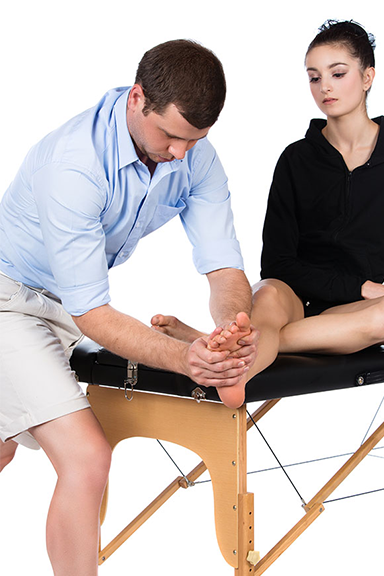
Ankle sprain Physiotherapist Treatment
Stage 2 – 4 weeks
Once the swelling and pain are under control, stretching and strengthening exercises can begin. Physiotherapist focuses on restoring your ankle’s flexibility, range of movement and strength while you are still healing from the ligament tears. We will train you in the proper use of crutches and teach you how to bear weight gradually. Physio treatment will also involve passive joint mobilization to regain full range of movement, deep massage to break up scarring caused by the sprain.
- Sub-Acute Soft Tissue Injury Treatment
- Joint mobilisations
- Kinesiology Tape
- Supportive Taping & Strapping
- Laser treatment
- Ice / Heat Packs
- Medications
Stage 3 – 2 weeks
We will guide you when it’s safe to start putting weight on the ankle, remove the moon boot and start walking short distances. We will give you specific functional exercises to help you return to full function. Once you can stand on your ankle again, we will prescribe exercise routines to strengthen your muscles and ligaments and increase your flexibility, balance and coordination. Later, you may walk, jog and run with your ankle taped or in a supportive ankle brace.
To prevent future sprained ankles, we will give you more advanced exercises that you will need to do, to strengthen the muscles, and keep the ankle joint stable. Also pay attention to your body’s warning signs to slow down when you feel pain or fatigue, and stay in shape with good muscle balance, flexibility and strength in your soft tissues.
- Stretching Exercises
- Strength Exercises
- Closed Kinetic Chain Exercises
- Eccentric Exercises
- Proprioception & Balance Exercises
- Agility & Sport-Specific Exercises
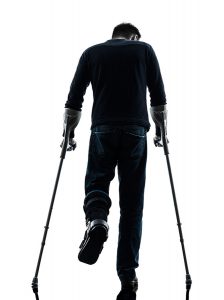
Can you walk on a sprained ankle?
Well, No. The ligaments that surround the ankle is responsible to hold the joint stable (ankle joint stability), and if these ligaments are partially or completely torn, when you put your weight on the ankle, the ligaments will take the tension – This will cause a sharp stinging pain over the ligament. Apart from that the tibia and fibula will slide forward and backward without the support of the ankle ligaments. Please do not injure yourself further, have the experts take a look.
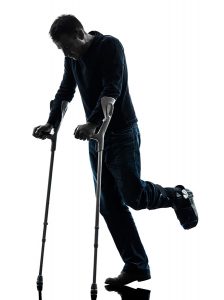
When is it safe to start getting active again?
Usually, a good indication will be if you can hop on one leg ten times without any pain.
When is Surgery necessary?
For Grade 3 injuries only and other compromised conditions. In some cases, the ligaments don’t reattach because the two sides of the ligament are too far apart. Serouis syndesmosis injuries usually are surgically repaired.
Differential diagnosis
Less common injuries excluded from the differential diagnosis include:
- Ankle pain
- Ankle fracture (medial/lateral malleolus, distal tibia/fibular)
- Damage to the medial ligament (deltoid)
- Dislocated ankle
- Sinus Tarsi Syndrome
- Other soft tissue damage e.g. muscle strain
- Anterior ankle Impingement
- Tarsal Tunnel Syndrome
- Cartilage or osteochondral lesions
- Peroneal Tendinopathy
- Posterior Tibial Tendon Dysfunction
